
Presented by Charles & Linda Raabe
Mactan Island, The Philippines
© 2008 All Rights Reserved
CORALS & INVERTEBRATES
While living near coral reefs affords a wonderful opportunity to collect our own
specimens, it also comes with a great responsibility. When faced with
the vast multitudes of species that can be found on a reef, the desire
to fill ones collection bucket can be a great temptation. Please, if
you can do your own collecting, show some restraint and only collect
those specimens that you know will do well in your aquarium system.
I have found that it is best to take only a very small fragment of a specific species and keep it within my aquarium for at least three months to ensure that it will thrive. If so, then I can go back and collect a larger fragment. I really want to stress the need for restraint and patience.
It is far too easy, and far too damaging to go out and collect an entire aquarium's worth of corals and invertebrates only to find that later on, a "better" coral is found and you now have to remove something in order to make room for the more desirable species. Please be patient and enjoy the time it will take to find those truly unique species that await you.
The Equipment - I have found that a simple and inexpensive biscuit or cookie bulk bucket works best. Both of which come in a variety of sizes. I use both a large and a smaller bucket depending on my goals for that days diving or snorkeling trip.
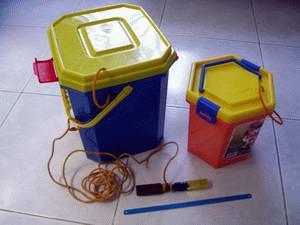 As you can see, besides any snorkeling or scuba gear, it is quite simple to create a safe method in which to store your newly collected pets. Depending upon my collecting goals for that day, I will use the larger bucket when collecting live rock, sand or if I have a
particularly large coral in mind. The smaller bucket is most often used as it is easier to carry and manage in the water while allowing me to collect something that I may happen to find during my trip over the reefs. More often than not, I get out of the water with an empty bucket as I am extremely selective in what I will take from the reefs. A frame
of mind that I hope you will be able to develop as well.
As you can see, besides any snorkeling or scuba gear, it is quite simple to create a safe method in which to store your newly collected pets. Depending upon my collecting goals for that day, I will use the larger bucket when collecting live rock, sand or if I have a
particularly large coral in mind. The smaller bucket is most often used as it is easier to carry and manage in the water while allowing me to collect something that I may happen to find during my trip over the reefs. More often than not, I get out of the water with an empty bucket as I am extremely selective in what I will take from the reefs. A frame
of mind that I hope you will be able to develop as well.
In the above photo, you can see that I have a wood chisel tied to the bucket by a 15 foot (4 meter) length of nylon rope. This is done so that as I snorkel, the bucket can float on the surface out of my way. The floating bucket also serves as a good visual target for small boats and jet skis to aim for. As it never ceases to amaze me that a tourist on a jet ski must show off their new found driving skills by racing past you within a matter of yards.
The chisel is used when removing larger items from the substrates that you know will not be damaged by chopping or breaking it off with the chisel. The idea is to either chop or chisel the rock the coral is on, so that you come away with a piece of rock with a coral on it. If you see that there is a good chance you will damage the coral, then move on and do not risk damaging a coral for any reason.
For soft encrusting types such as button polyps, I lay the chisel against bare rock next to them and push forward while moving the chisel in a side to side motion to scrape off the top layer of rock under the polyps, if you are doing it correctly, you will come away with a strip of polyps attached to a very thin (1/8th to 1/4") layer of rock. You can also use the hack saw blade to remove a thin layer of rock that the polyps or coral is growing upon.
In the sand beds, I also use the chisel as a small shovel to dig out feather dusters or any other sand "planted" life. Remember, when collecting, think small, a few large corals will fill your tank in no time, I much prefer and enjoy having a lot of small items in my tank, as it allows much more diversity. I have also noticed that small corals or fragments always do much better in my tank when collected as new or young growth.
I also carry a hack saw blade with me (stored in the large bucket) since it is all but impossible to remove an encrusting or plating coral from its rock with the chisel. To attempt to do so with the chisel, will ensure you break the coral into many pieces. The hack saw blade allows you to "slice" any encrusting life off of the rocks while keeping that life attached to what it grew upon. You will most likely be surprised how easy the blade cuts through calcium carbonate and ensures you do not damage the animal you are trying to collect.
For those of you who are not sailors or fishermen, this is the knot that I use to attach the rope to the bucket and the chisel. The beauty of this knot is that it gets tighter the more it is pulled against, ensuring that you will not lose your bucket due to a loose knot. It is also easily undone as well.
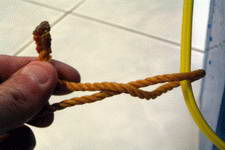
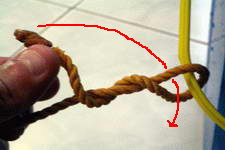
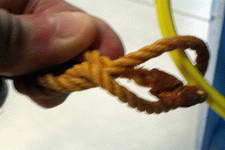

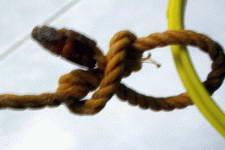
When using your collecting bucket during scuba diving, please ensure you keep it tied off with a rope just as you would when snorkeling. This will prevent you having to constantly set it down or hold onto it when trying to work on something. If you do have to set the bucket down, please ensure it is placed onto bare rock or sand.
Never allow yourself or the bucket to touch any living corals or inverts. Doing so just ensures you are destroying life by simply being clumsy. When I am scuba diving, I of course have to fill the bucket with water to allow myself to get down to depth. With the bucket holding nothing but water, it will float free above you out of the way. But once you place anything else into the bucket, you will have to hold the bucket from then on.
This leaves you with a good length of rope to hang onto as well or it will tangle yourself up. A dangerous thing to have happen while scuba diving. As such, When I am forced to hold the bucket, I undo the knot on the buckets handle and place the chisel and rope into my diving vest's (BCD) pocket. If you still need to use the chisel, you can easily remove it from the pocket while leaving the rest of the rope remaining tucked into the pocket out of the way.
Since you will be diving with a length of rope, I strongly advise you to also carry a dive knife in the event you must cut your way free of an entanglement. Your safety should always come first before all other concerns.
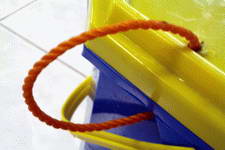
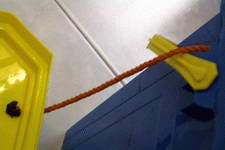 After having lost a few lids to the ocean currents, I realized
that it was best to attach the lid to the bucket with a short length of
nylon rope. Being nylon, once you put the rope through the holes of the
bucket and lid, you can melt the ends of the rope to form a thick spot
that will hold the rope in place. Be careful when doing so since the
melted nylon (plastic) can give you a very nasty burn.
After having lost a few lids to the ocean currents, I realized
that it was best to attach the lid to the bucket with a short length of
nylon rope. Being nylon, once you put the rope through the holes of the
bucket and lid, you can melt the ends of the rope to form a thick spot
that will hold the rope in place. Be careful when doing so since the
melted nylon (plastic) can give you a very nasty burn.
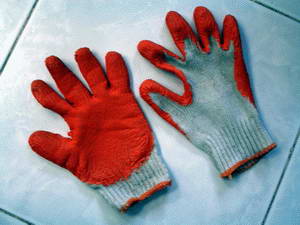 For your own personal safety, I strongly recommend that you get
a pair of rubberized gloves. These can be found in the garden sections
of department stores, or at your local markets. Please do not use your
new found hand invisibility to hold onto living corals. When I see
something that I wish to collect, the first thing I do before all else,
is to find a bare rock or spot on a rock that I can use to hold onto.
Even then, without a glove, you will find out sooner or later that even
what looks like a bare spot will have some tiny, unseen animal growing
on it that can and will give you a nasty sting or cut. Human skin is no
match against the defenses most reef animals have.
For your own personal safety, I strongly recommend that you get
a pair of rubberized gloves. These can be found in the garden sections
of department stores, or at your local markets. Please do not use your
new found hand invisibility to hold onto living corals. When I see
something that I wish to collect, the first thing I do before all else,
is to find a bare rock or spot on a rock that I can use to hold onto.
Even then, without a glove, you will find out sooner or later that even
what looks like a bare spot will have some tiny, unseen animal growing
on it that can and will give you a nasty sting or cut. Human skin is no
match against the defenses most reef animals have.
I will end this section with a safety note. It is always a wise idea to look where you are placing your hand on any rock that you may hold onto, after the first sea urchin spine into my finger, I learned that lesson quickly. Also if you are going to look under a ledge, do not just grab the top of the ledge and stick your face under the ledge, I did that once only to see that the hand I was holding on with was mere inches from a lion fish. Never for any reason, put your hand or a finger into any hole. There are far to many creatures that could be at home that will take offense to having your hand in their face and will most likely let you know it, in a very painful manner. But above all, please be respectful of the reef at all times.
I have found that it is best to take only a very small fragment of a specific species and keep it within my aquarium for at least three months to ensure that it will thrive. If so, then I can go back and collect a larger fragment. I really want to stress the need for restraint and patience.
It is far too easy, and far too damaging to go out and collect an entire aquarium's worth of corals and invertebrates only to find that later on, a "better" coral is found and you now have to remove something in order to make room for the more desirable species. Please be patient and enjoy the time it will take to find those truly unique species that await you.
The Equipment - I have found that a simple and inexpensive biscuit or cookie bulk bucket works best. Both of which come in a variety of sizes. I use both a large and a smaller bucket depending on my goals for that days diving or snorkeling trip.
 As you can see, besides any snorkeling or scuba gear, it is quite simple to create a safe method in which to store your newly collected pets. Depending upon my collecting goals for that day, I will use the larger bucket when collecting live rock, sand or if I have a
particularly large coral in mind. The smaller bucket is most often used as it is easier to carry and manage in the water while allowing me to collect something that I may happen to find during my trip over the reefs. More often than not, I get out of the water with an empty bucket as I am extremely selective in what I will take from the reefs. A frame
of mind that I hope you will be able to develop as well.
As you can see, besides any snorkeling or scuba gear, it is quite simple to create a safe method in which to store your newly collected pets. Depending upon my collecting goals for that day, I will use the larger bucket when collecting live rock, sand or if I have a
particularly large coral in mind. The smaller bucket is most often used as it is easier to carry and manage in the water while allowing me to collect something that I may happen to find during my trip over the reefs. More often than not, I get out of the water with an empty bucket as I am extremely selective in what I will take from the reefs. A frame
of mind that I hope you will be able to develop as well.In the above photo, you can see that I have a wood chisel tied to the bucket by a 15 foot (4 meter) length of nylon rope. This is done so that as I snorkel, the bucket can float on the surface out of my way. The floating bucket also serves as a good visual target for small boats and jet skis to aim for. As it never ceases to amaze me that a tourist on a jet ski must show off their new found driving skills by racing past you within a matter of yards.
The chisel is used when removing larger items from the substrates that you know will not be damaged by chopping or breaking it off with the chisel. The idea is to either chop or chisel the rock the coral is on, so that you come away with a piece of rock with a coral on it. If you see that there is a good chance you will damage the coral, then move on and do not risk damaging a coral for any reason.
For soft encrusting types such as button polyps, I lay the chisel against bare rock next to them and push forward while moving the chisel in a side to side motion to scrape off the top layer of rock under the polyps, if you are doing it correctly, you will come away with a strip of polyps attached to a very thin (1/8th to 1/4") layer of rock. You can also use the hack saw blade to remove a thin layer of rock that the polyps or coral is growing upon.
In the sand beds, I also use the chisel as a small shovel to dig out feather dusters or any other sand "planted" life. Remember, when collecting, think small, a few large corals will fill your tank in no time, I much prefer and enjoy having a lot of small items in my tank, as it allows much more diversity. I have also noticed that small corals or fragments always do much better in my tank when collected as new or young growth.
I also carry a hack saw blade with me (stored in the large bucket) since it is all but impossible to remove an encrusting or plating coral from its rock with the chisel. To attempt to do so with the chisel, will ensure you break the coral into many pieces. The hack saw blade allows you to "slice" any encrusting life off of the rocks while keeping that life attached to what it grew upon. You will most likely be surprised how easy the blade cuts through calcium carbonate and ensures you do not damage the animal you are trying to collect.
For those of you who are not sailors or fishermen, this is the knot that I use to attach the rope to the bucket and the chisel. The beauty of this knot is that it gets tighter the more it is pulled against, ensuring that you will not lose your bucket due to a loose knot. It is also easily undone as well.





When using your collecting bucket during scuba diving, please ensure you keep it tied off with a rope just as you would when snorkeling. This will prevent you having to constantly set it down or hold onto it when trying to work on something. If you do have to set the bucket down, please ensure it is placed onto bare rock or sand.
Never allow yourself or the bucket to touch any living corals or inverts. Doing so just ensures you are destroying life by simply being clumsy. When I am scuba diving, I of course have to fill the bucket with water to allow myself to get down to depth. With the bucket holding nothing but water, it will float free above you out of the way. But once you place anything else into the bucket, you will have to hold the bucket from then on.
This leaves you with a good length of rope to hang onto as well or it will tangle yourself up. A dangerous thing to have happen while scuba diving. As such, When I am forced to hold the bucket, I undo the knot on the buckets handle and place the chisel and rope into my diving vest's (BCD) pocket. If you still need to use the chisel, you can easily remove it from the pocket while leaving the rest of the rope remaining tucked into the pocket out of the way.
Since you will be diving with a length of rope, I strongly advise you to also carry a dive knife in the event you must cut your way free of an entanglement. Your safety should always come first before all other concerns.

 After having lost a few lids to the ocean currents, I realized
that it was best to attach the lid to the bucket with a short length of
nylon rope. Being nylon, once you put the rope through the holes of the
bucket and lid, you can melt the ends of the rope to form a thick spot
that will hold the rope in place. Be careful when doing so since the
melted nylon (plastic) can give you a very nasty burn.
After having lost a few lids to the ocean currents, I realized
that it was best to attach the lid to the bucket with a short length of
nylon rope. Being nylon, once you put the rope through the holes of the
bucket and lid, you can melt the ends of the rope to form a thick spot
that will hold the rope in place. Be careful when doing so since the
melted nylon (plastic) can give you a very nasty burn. For your own personal safety, I strongly recommend that you get
a pair of rubberized gloves. These can be found in the garden sections
of department stores, or at your local markets. Please do not use your
new found hand invisibility to hold onto living corals. When I see
something that I wish to collect, the first thing I do before all else,
is to find a bare rock or spot on a rock that I can use to hold onto.
Even then, without a glove, you will find out sooner or later that even
what looks like a bare spot will have some tiny, unseen animal growing
on it that can and will give you a nasty sting or cut. Human skin is no
match against the defenses most reef animals have.
For your own personal safety, I strongly recommend that you get
a pair of rubberized gloves. These can be found in the garden sections
of department stores, or at your local markets. Please do not use your
new found hand invisibility to hold onto living corals. When I see
something that I wish to collect, the first thing I do before all else,
is to find a bare rock or spot on a rock that I can use to hold onto.
Even then, without a glove, you will find out sooner or later that even
what looks like a bare spot will have some tiny, unseen animal growing
on it that can and will give you a nasty sting or cut. Human skin is no
match against the defenses most reef animals have.I will end this section with a safety note. It is always a wise idea to look where you are placing your hand on any rock that you may hold onto, after the first sea urchin spine into my finger, I learned that lesson quickly. Also if you are going to look under a ledge, do not just grab the top of the ledge and stick your face under the ledge, I did that once only to see that the hand I was holding on with was mere inches from a lion fish. Never for any reason, put your hand or a finger into any hole. There are far to many creatures that could be at home that will take offense to having your hand in their face and will most likely let you know it, in a very painful manner. But above all, please be respectful of the reef at all times.
FISH
This area of collecting can be somewhat frustrating, only because even the slowest of fish can make us look foolish as we chase them in a sponge bob square pants fashion. Since I am usually restricted to just snorkel gear and how long I can hold my breath, I remain with just a large aquarium net and my wit. Which fails me more times than not.
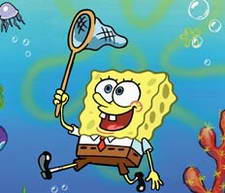 The only manner that I have been able to catch anything with such a relatively small net is to remain in the shallows, watch rocky areas and when a fish that I want is spotted, I approach very slowly and watch the fish's reaction and its preferred avenue of escape.
The only manner that I have been able to catch anything with such a relatively small net is to remain in the shallows, watch rocky areas and when a fish that I want is spotted, I approach very slowly and watch the fish's reaction and its preferred avenue of escape.
Instead of chasing the fish with the net, I position the net in a place where it looks as though the fish would have no other choice to go if pushed in that direction, I then use my free hand to scare the fish into that direction. The easiest fish so far for me, has been small triggers, if you scare or chase them hard enough, they will dive into holes in the rocks, which can then be lifted out of the water and the trigger will fall out of the hole into the awaiting bucket or net.
To do any serious fish catching, one would need scuba gear and large nets designed to be set up along a reef wall, which would guide any fish into a trap area of the netting. This would be a bit much to purchase and set up for the few fish we would be interested in and is why for fish species out of my depth range or just to fast for me, I purchase those types from the local fish collectors.
You will in due time see small fish using branching corals as their homes. Please do not attempt to catch these fish as you are sure to do great damage to the coral. Green clown gobys and a variety of damsels are examples of fish that are best left where they are simply out of respect for their coral homes. Once again, I must stress that you check local collecting laws. Some species of fish may be protected or entire reef areas may be off limits to such activity. Above all, always remain respectful of the reef, do not touch or bump against it, nor do any damage in a collecting attempt, if this can not be achieved, then please pass that item up and move on. Be safe and enjoy the reefs!
 The only manner that I have been able to catch anything with such a relatively small net is to remain in the shallows, watch rocky areas and when a fish that I want is spotted, I approach very slowly and watch the fish's reaction and its preferred avenue of escape.
The only manner that I have been able to catch anything with such a relatively small net is to remain in the shallows, watch rocky areas and when a fish that I want is spotted, I approach very slowly and watch the fish's reaction and its preferred avenue of escape.Instead of chasing the fish with the net, I position the net in a place where it looks as though the fish would have no other choice to go if pushed in that direction, I then use my free hand to scare the fish into that direction. The easiest fish so far for me, has been small triggers, if you scare or chase them hard enough, they will dive into holes in the rocks, which can then be lifted out of the water and the trigger will fall out of the hole into the awaiting bucket or net.
To do any serious fish catching, one would need scuba gear and large nets designed to be set up along a reef wall, which would guide any fish into a trap area of the netting. This would be a bit much to purchase and set up for the few fish we would be interested in and is why for fish species out of my depth range or just to fast for me, I purchase those types from the local fish collectors.
You will in due time see small fish using branching corals as their homes. Please do not attempt to catch these fish as you are sure to do great damage to the coral. Green clown gobys and a variety of damsels are examples of fish that are best left where they are simply out of respect for their coral homes. Once again, I must stress that you check local collecting laws. Some species of fish may be protected or entire reef areas may be off limits to such activity. Above all, always remain respectful of the reef, do not touch or bump against it, nor do any damage in a collecting attempt, if this can not be achieved, then please pass that item up and move on. Be safe and enjoy the reefs!
This mirror is being hosted with the permissions of the original content creator for preservation and educational purposes.
